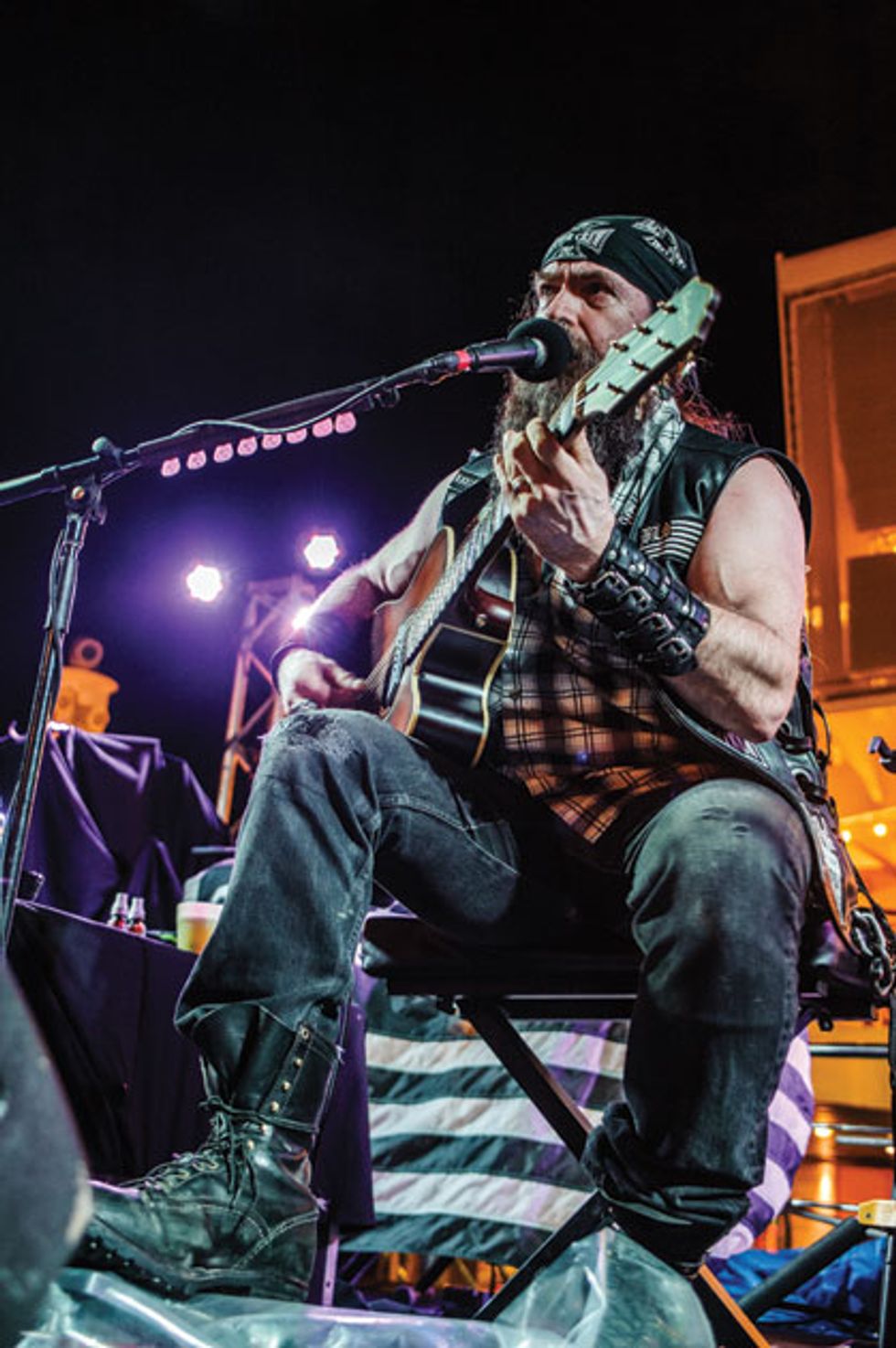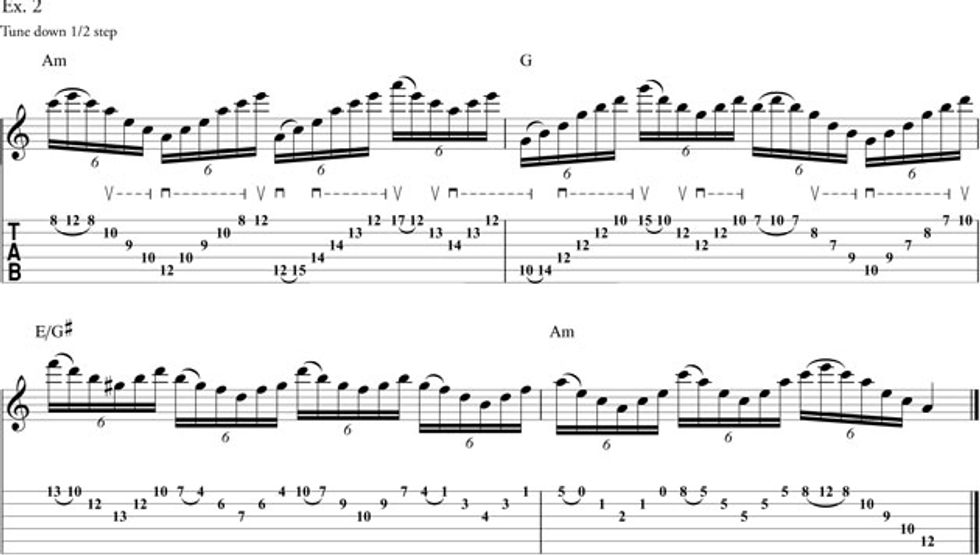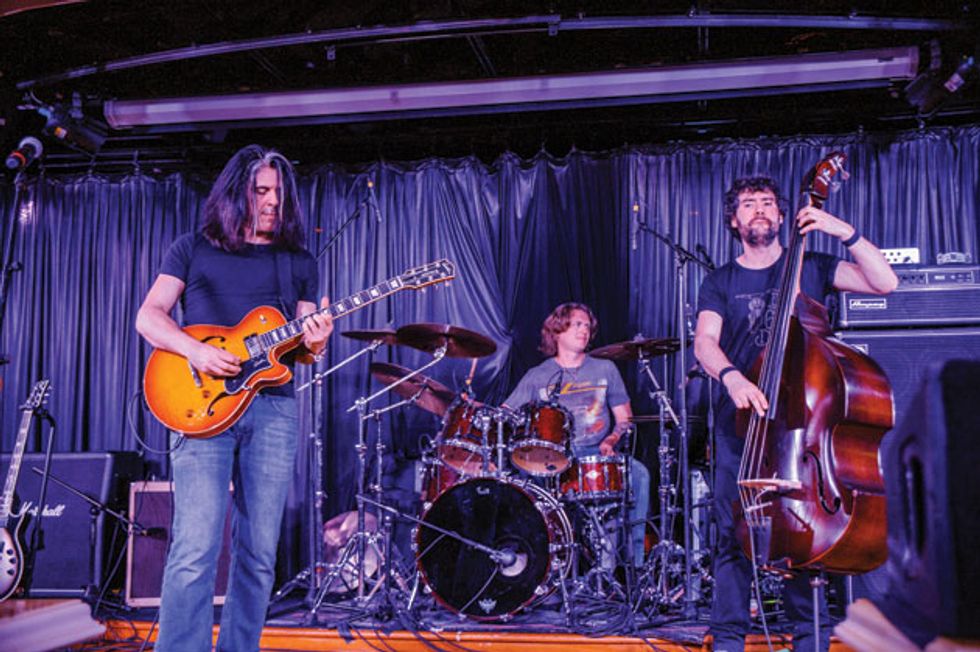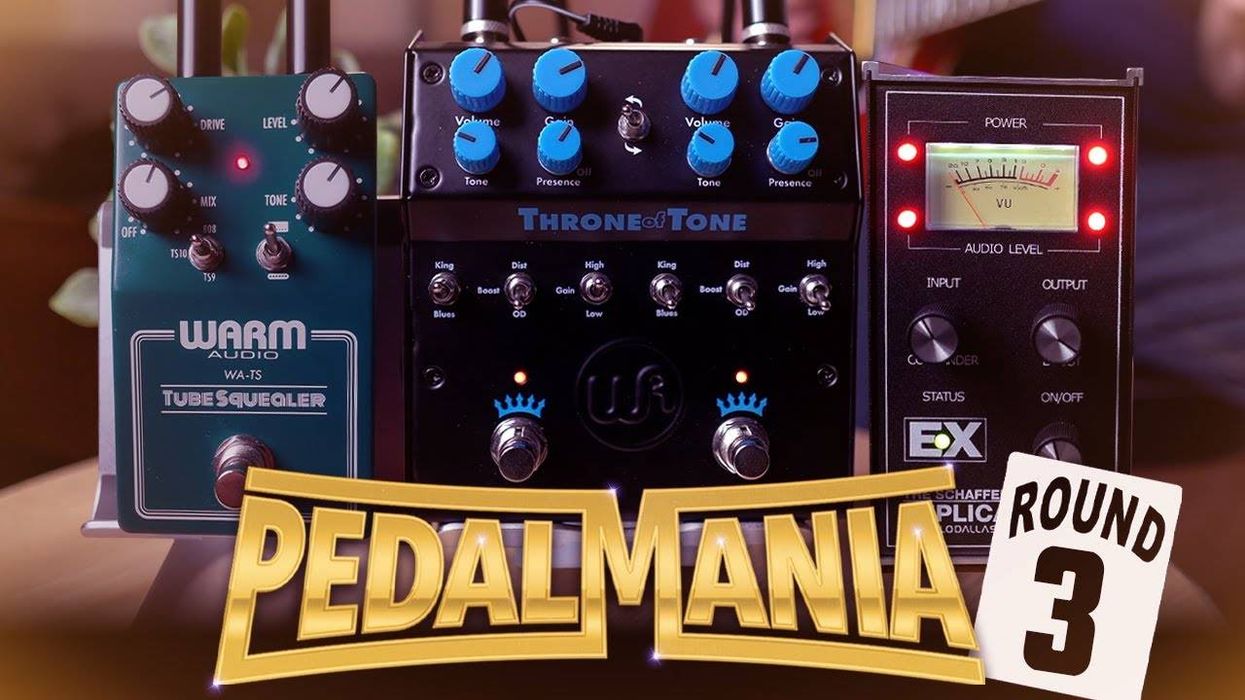On a windy pool deck somewhere off the coast of Florida, Ron “Bumblefoot” Thal rips into the galloping riff of Ozzy’s “I Don’t Know” with his gold Vigier doubleneck. As the opening track from the Black Sabbath frontman’s 1980 landmark solo debut, Blizzard of Ozz, the choice is fitting, since the song marked the first time many guitarists were floored by Randy Rhoads’ nimble-fingered leads and dynamite riffs. Right now, it’s also the kick-off for a set by drummer Brian Tichy’s Randy Rhoads Remembered ensemble.On the first night of the inaugural voyage of the Axes & Anchors cruise, it soon becomes hard to tell if the slightly tilting motion is coming from the ocean waves or the throngs of fans rocking in rhythm to some of Ozzy’s greatest hits.
Unlike other music-themed cruises, A&A was designed to appeal more to musicians than fans. Organizer Ann Squire had the idea for the cruise several years ago on a road trip to Colorado to see Queensrÿche.
“We thought it would be great to have 10 workshops on a cruise, and the next thing we knew we had 35,” she says, laughing. These workshops, where budding guitarists get up close with their favorite players to inquire just how they did what they did, separated A&A from other, performance-based cruises.
The lineup was handpicked by Squire and her staff, and included legendary figures Zakk Wylde and Yngwie Malmsteen, and modern metal masters such as Alex Skolnick, Marty Friedman, and Chris Broderick. Sadly, Michael Schenker had to cancel due to the death of a band member shortly before the cruise.
“If this had been around when I was 17 or 18 and had Al Di Meola, John McLaughlin, or Frank Marino, I would have saved up and gone—without a doubt,” says Wylde, who was aboard to show his somewhat more acoustic side to coincide with the upcoming release of his new album, Book of Shadows II.
“Originally, the idea was to only feature guitarists,” Squire relates. After some feedback, Squire and her partners felt they needed additional acts to attract a younger generation, so they brought on Breaking Benjamin, Motionless In White, Thousand Foot Krutch, and others. Squire affectionately refers to them as “Octane” bands—after the Sirius/XM station that features contemporary heavy rock.
With nearly 45 performances and the workshops packed into a four-night cruise—February 20 through 24—it was inevitable that some schedule conflicts occurred, but since most of the acts performed more than once, the chance of missing an artist entirely was next to zero.
YouTube It
During Zakk Wylde’s performance of “Stillborn,” he wielded an Epiphone Masterbuilt acoustic and got up close with the audience as bandmate Dario Lorina backed him up with some sensitive keyboard work. Check out 1:08, where Zakk takes a seat in the crowd and provides an incredible look at his ruthless picking technique.
For Those About to Shred
The Carnival Victory is an impressive vessel by any standards. As soon as I stepped into the Atrium, a centrally located hub that hosted several performances and more intimate Q&A sessions, the sheer expansiveness of the modern cruise ship was somewhat overwhelming. With 13 decks, 24-hour buffets, a full casino, an art gallery, mini golf, a multi-level water slide, a spa, and five performance venues, it’s easy to forget that you’re actually floating in the middle of the ocean.
Most artists were featured in a mix of large-stage performances in either the Caribbean Theater or at the Pool Stage, and workshops or Q&A sessions in the smaller venues. The all-you-can-hear music schedule mirrored the overwhelming amount of food and drinks that filled the ship.
Although many of the guests viewed this vacation as a way to beef up their guitar skills, the first night was aimed at setting the tone with a packed Pool Stage schedule that included a rare U.S. appearance by Japan-based, ex-Megadeth shredder Marty Friedman, the soulful electro-acoustic vibes of Zakk Wylde, and an impressive all-star tribute to an icon of modern rock guitar, the late Randy Rhoads.
While the Victory headed from Miami toward the first port of call, Key West, Marty Friedman and his band (guitarist Jordan Ziff, bassist Kiyoshi Manii, and powerhouse drummer Chargeeee) tore through an intense set of tunes from Friedman’s latest release, Inferno. Ziff, who bears an uncanny resemblance to Friedman circa ’86, was in lockstep with his boss throughout the set, while Chargeeee’s Animal-esque performance and fireball energy created a buzz that kept fans talking for days.
A Zakk Wylde “acoustic” show might portend musical elements of legendary folk-rockers like Neil Young and Bob Dylan, but shortly into the first tune the comparisons faded. Wylde used a trio of Epiphone Masterbuilt acoustics run through a pair of his signature MXR ZWR Berzerker Overdrive pedals and a Roland JC-120 to create a decidedly distorted sound that served as a fitting platform for trading Di Meola-inspired licks with Black Label Society bandmate Dario Lorina. “I loved seeing Zakk tearing up an acoustic—just giving it everything he gives,” Bumblefoot mentioned the next afternoon.
Tichy, who performed with Ozzy on the Ozzfest tour in 2000, partnered up with Randy Rhoads’ family to develop an all-star tribute to the late guitarist. Usually, Randy Rhoads Remembered performances are scheduled around the NAMM show, but the cruise proved to be a natural fit, since you couldn’t swing a life preserver without hitting someone who could play the “Crazy Train” solo note-for-note. In addition to Bumblefoot, Alex Skolnick made an appearance during the triple-R set with an energizing performance on “Flying High Again.” Legendary bassist Rudy Sarzo, who toured with Rhoads in Osbourne’s band, served up the low end for the night (his highlight was the intro on “Believer”), while Kill Devil Hill vocalist Dewey Bragg did an admirable job on vocals. Jeff Watson, Type O Negative drummer Johnny Kelly, and guitarist Marzi Montazeri made appearances to help power through nearly all of the material on Ozzy’s first two solo albums.
Teachable Moments
Even though most clinics on the schedule listed a specific focus, many morphed into informal but informed Q&A sessions. Act of Defiance guitarist Chris Broderick opened up the Caribbean Theater with a surprisingly large audience for 9 a.m. During his clinic, where everyone had guitars in their laps and was ready to soak up some knowledge, the feeling of community was palpable.
“There’s that instant common bond that everyone has,” says Broderick of the vibe on the cruise. “Complete strangers can start head banging and talking metal.” The welcoming vibes brought out a ton of questions from the crowd, and Broderick interspersed those by playing some tunes through his Axe-Fx-powered rig over some backing tracks on his laptop.
An inquiring attendee asked about how Broderick has such mind-bending dexterity with his ring and pinky fingers. “I seem to hit a wall with tempo and accuracy more quickly with those fingers,” the attendee said. As accomplished a musician as Broderick is, he still strives to identify holes in his playing and creates compositions and exercises to help isolate and fix them. Broderick’s answer to the attendee was Ex. 1, a simple neo-classical-style lick that forces the lackluster fingers to get up to speed. (Bonus idea: Broderick suggests moving the same motif up and down the natural minor scale.)
Once Broderick wrapped up a few last-minute questions, the crowd moved towards the Pool stage where Ron “Bumblefoot” Thal was holding court. The windy conditions might have proven difficult for some, but didn’t faze Thal. “I’ve done crazier,” he recounts. “Once in Buffalo it was so cold—I just took my shirt off and ran into it.” As the queries flowed, Thal’s mix of humor and otherworldly technique was as impressive as it was inspiring.
His approach to the clinic was to encourage players to get out of their own heads and move past the technical. “Once you have the knowledge of scales and modes, you have it. You don’t have to focus on it anymore in order to play,” says Thal. Of course, anyone who gets the chance to ask Thal a question always inquires about his infamous use of a thimble to explore the imaginary frets past the neck to produce everything from ultra-high birdcalls to attention-grabbing harmonics.
A little rain couldn’t stop Zakk Wylde from taking the stage on the opening night of the cruise. Armed with a trio of Epiphone Masterbuilt acoustics, Wylde played songs from his latest album, Book of Shadows II, and even dug out some jams from his 1994 solo debut, Pride & Glory. Photo by Annie Atlasman
Both Zakk’s and Yngwie’s clinics were scheduled for the afternoon at sea on the way to Nassau. Each was able to impart a bit of valuable knowledge to the masses, but most of the time was spent hearing these masters play up close and absorbing by osmosis. Wylde opened up with an unaccompanied guitar solo before Dario came out and the duo dug into a jammed-out, 12-minutes-plus version of “Machine Gun Man” from Pride and Glory.
Marshall Amplification’s artist relations chief Nick Bowcott was on hand to moderate Yngwie’s clinic and keep things moving. There’s magic in watching Yngwie play through his bag of harmonic-minor-flavored sweep licks. Even if the music isn’t your thing, the efficiency of his technique and unwavering dedication to his craft is something to behold. The throngs of “Yngwie Who?” shirts seemed to grow by the dozens after his performance and his clinic.
Berklee professor Joe Stump offered a great intro to sweep picking during his morning workshop. An Yngwie devotee, Stump provided everyone with extensive handouts demonstrating his approach to 3-, 4-, 5-, and 6-string sweep picking shapes. One of the most effective is shown in Ex. 2. It’s an excerpt from Stump’s solo on “Brothers in Shred” from his latest album, The Dark Lord Rises.
“The first figure is a standard 5-string A minor sweep shape,” explains Stump. “I added the hammer-on and pull-off to make it an even sextuplet.” The second half of the lick focuses on smaller, more manageable 3-string shapes that hop up and down the neck. “I’ll frequently mix and match arpeggio and sweep shapes that are all the same note value,” he explains.
Ready to Mingle
Probably the most appealing aspect of Axes & Anchors was how approachable many of the artists were. Even if you missed one of the clinics or Q&A sessions, it wouldn’t be difficult to run into Zakk, Marty, or Bumblefoot strolling around the pool deck or grooving along to one of the performances. Shortly after the meet-and-greet, where VIP attendees moved from station to station in order to get a pic with their favorite artists, Zakk Wylde, for example, was hanging around giving anyone interested some of his time.
The whole experience was a prime example of how going above and beyond a simple autograph or selfie might make a fan for life.
One of the more interesting Q&A sessions took place in the Atrium with Brian Tichy, Rudy Sarzo, and the Rhoads family (Randy’s brother Kelle and sister Kathy). Fans got to ask about Randy’s early years, Sarzo shared some stories from the road, and Tichy relayed a humorous story about using his audition for Ozzy to get out of a speeding ticket with a cop who was a metalhead.
After the performances, there were activities for the more nocturnal. You might find Zakk or Friedman hosting blackjack or craps in the casino, or Bumblefoot and Nick Bowcott getting up and jamming with fans on the 660 Guitars stage.
Shred Isn’t Dead
The stage in the Caribbean Theater was foggy with only the lights from 20-something Marshall heads illuminating the dozen or soMarshall cabs below. Rumor had it that due to weight restrictions, a few heads had to be left on shore. With a stage setup like that, it wasn’t much of a mystery as to who was about to perform. The crowd amped up with excitement, the band took the stage, and Yngwie proved to everyone in attendance why he’s still the king of neo-classical shred.
With one of his many blonde Fender Strats in hand, Yngwie had a somewhat surprisingly athletic stage show. He had plenty of room to move, since the rest of his band only covered about a third of the stage. One of the early highlights was “Rising Force,” the title track from his 1984 debut album, which showcased Malmsteen’s jackhammer rhythm riffs—an overlooked part of his style.
Testament’s Alex Skolnick and his trio, bassist Nathan Peck and drummer Matt Zebroski, planned two completely different performances for Axes & Anchors. The first took place in the Adriatic Lounge, which was the perfect setting for the group’s adventurous jazz-rock. Over their last few albums, the trio has moved farther from improv-infused versions of rock and metal classics to their own twisted compositions. Skolnick used the performance to debut two newly written tunes slated for a future release. “Culture Shock” was a country two-beat that showed off Skolnick’s deft hybrid picking as well as his willingness to open himself to influences and insert them into his compositions. The other tune, “Unbound,” started with a funky, slap-guitar intro that owed more to bassist Larry Graham than any of Skolnick’s jazzier inclinations.
One of the highlights of Skolnick’s metal set in the Caribbean Theater occurred when he invited Brian Tichy and Rudy Sarzo for a spirited take on Ozzy’s “Mr. Crowley.” All three did time with Ozzy, but none of their tenures overlapped. Skolnick even asked if anyone in the crowd would be interested in tackling the vocals, before he stepped up and did an admirable job. It was another example of the once-in-a-lifetime collaborations that happen when you have a boatful of musicians and plenty of time to rock.
Mama, I’m Coming Home By nearly all accounts, the maiden voyage of Axes & Anchors was a success. Squire says plans are in the works for the next installment, which will likely take place in 2017, and the goal will be to attract more people with a more diverse lineup. “Throughout the cruise, and even afterwards, many artists gave us feedback about how to improve it for next year,” she says.
After the ship pulled into the Port of Miami, the now-bonded community of guitarists took home some inspiration from a long weekend at sea. For Skolnick, it was back to work. He flew straight out of Miami to join his bandmates in Testament. (Glen Drover, who’s played in Megadeth and King Diamond, covered a few gigs for Skolnick while he was on the cruise.)
Even the artists onboard took away some new tricks and were exposed to new bands. “I really enjoyed getting up early to check out Jeff Watson,” Thal said. “His eight-finger tapping stuff was just smooth as hell.” Wylde mentioned, “I think it’s cool that Breaking Benjamin and Motionless In White are on the cruise, because it gives a nice break from all the guitar guys. It adds a little variety.” As Thal put it, “If you love rock guitar this is the place you should have been.”
Alex Skolnick did double duty, performing with his own jazz-informed trio as well as guesting for a visceral take on “Flying High Again” during the Randy Rhoads Remembered concert. Photo by Annie Atlasman
Alex Talks Eddie
Edward Van Halen remains a looming figure—despite his absence—over an event like Axes & Anchors. Alex Skolnick shared his thoughts about Eddie’s natural mastery with Premier Guitar:
“I consider Edward Van Halen’s early guitar work as inspiring today as it was during Van Halen’s prime (pre-1984). While this rarely causes any surprises, eyebrows do get raised whenever I express the opinion that too much focus is placed on Eddie’s two-handed tapping, speed picking, and other attention-getting elements, and not nearly enough on some of his other qualities such as feel, vibrato, groove, and riffs. One thing that is most often overlooked is Eddie’s use of rule-breaking melodic patterns. These tend to be deceptively simple in concept and brilliantly placed. For example, let’s look at the ascending line as heard in ‘I’m the One.’ Starting on the 5th string, this sequential pattern backtracks by one note between strings 3 and 4 and resolves to the root (A) on the 1st string. Other than those two exceptions, this lick is just a simple three-note pattern all the way across the strings that don’t follow a particular scale or mode. Another great example is the intro and solo to ‘Hot for Teacher.’
“Eddie claims no knowledge of scales or modes, which makes sense when you study his work. However, while he (along with Hendrix, Wes Montgomery, and a few others) benefited from being a pure ‘ear’ player, the ability to translate that into an innovative approach is very, very rare. Most of us are better off learning at least some music theory.”











![Rig Rundown: AFI [2025]](https://www.premierguitar.com/media-library/youtube.jpg?id=62064741&width=1245&height=700&quality=70&coordinates=0%2C0%2C0%2C0)












 Shop Scott's Rig
Shop Scott's Rig













 Zach loves his Sovtek Mig 60 head, which he plays through a cab he built himself at a pipe-organ shop in Denver. Every glue joint is lined with thin leather for maximum air tightness, and it’s stocked with Celestion G12M Greenback speakers.
Zach loves his Sovtek Mig 60 head, which he plays through a cab he built himself at a pipe-organ shop in Denver. Every glue joint is lined with thin leather for maximum air tightness, and it’s stocked with Celestion G12M Greenback speakers.












![Devon Eisenbarger [Katy Perry] Rig Rundown](https://www.premierguitar.com/media-library/youtube.jpg?id=61774583&width=1245&height=700&quality=70&coordinates=0%2C0%2C0%2C0)






